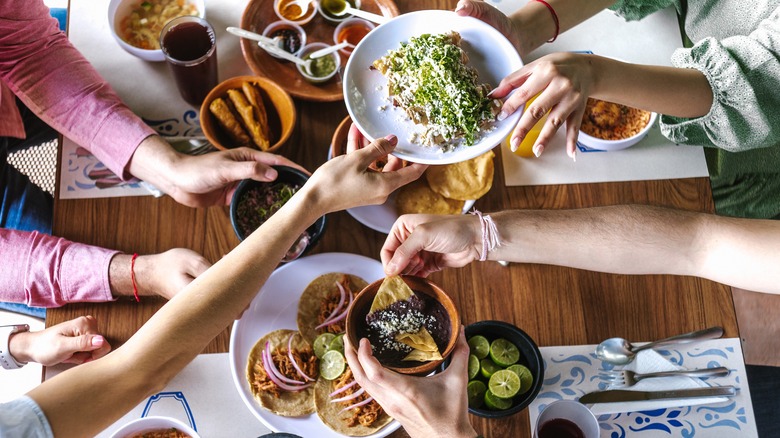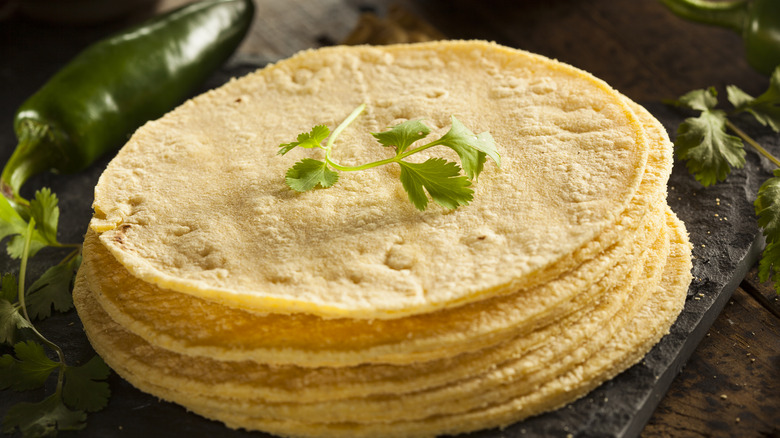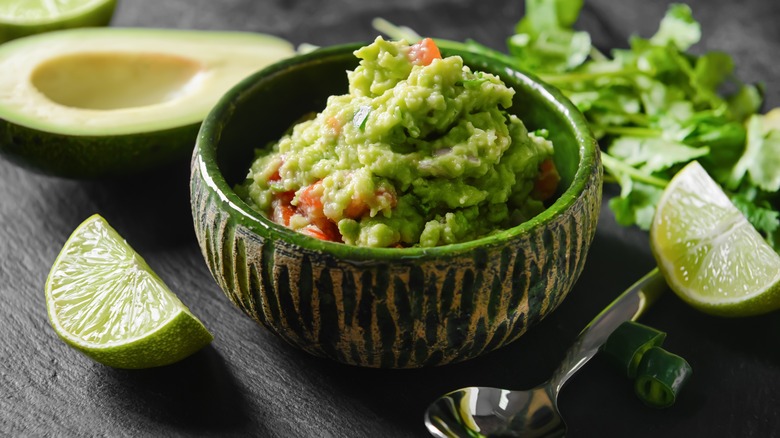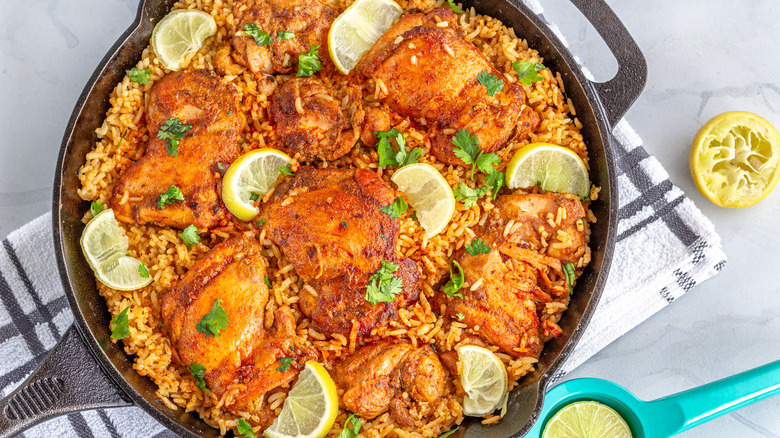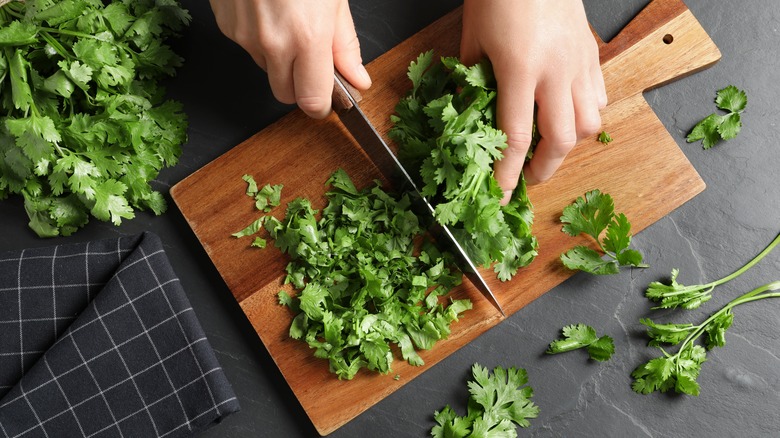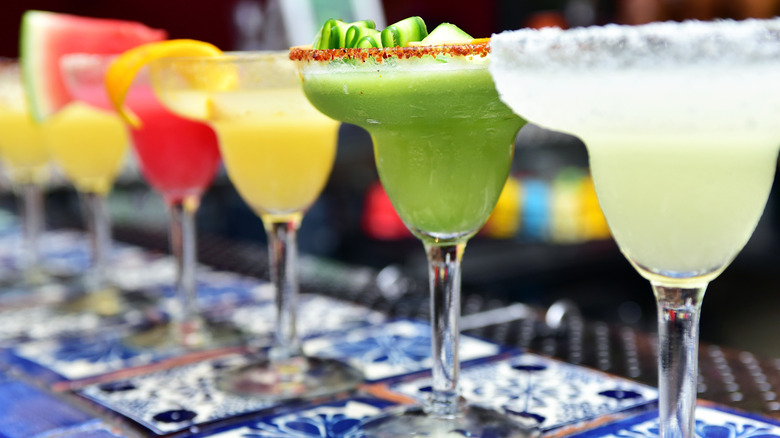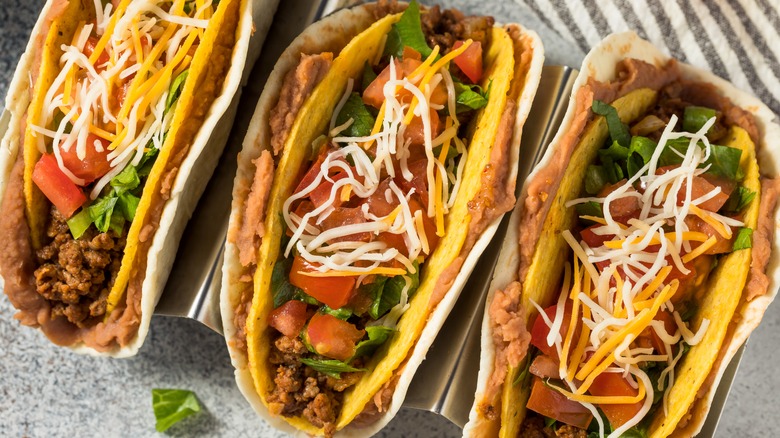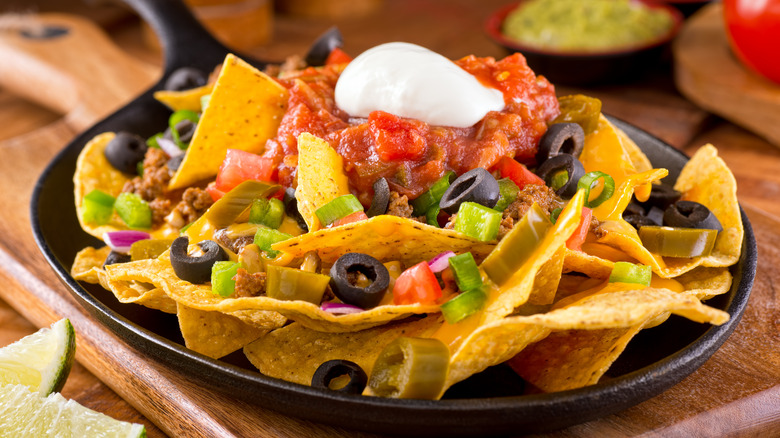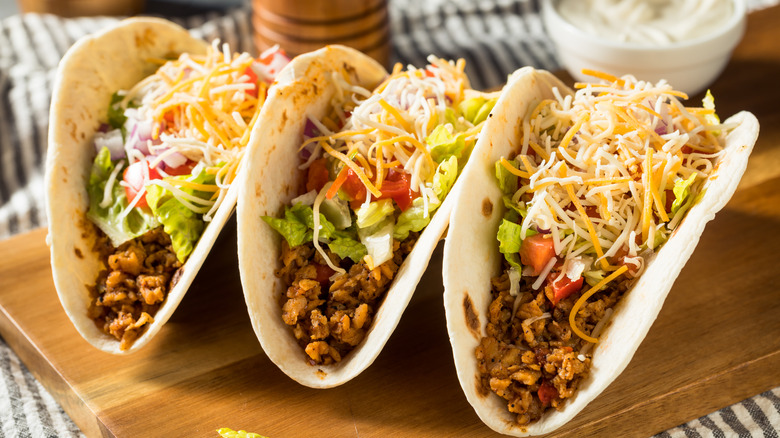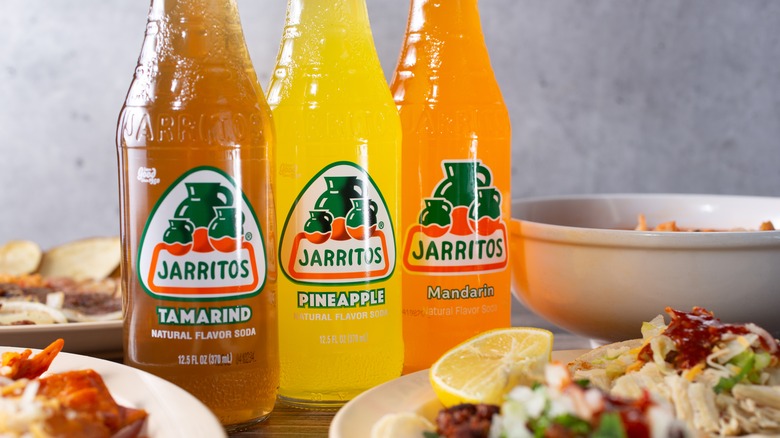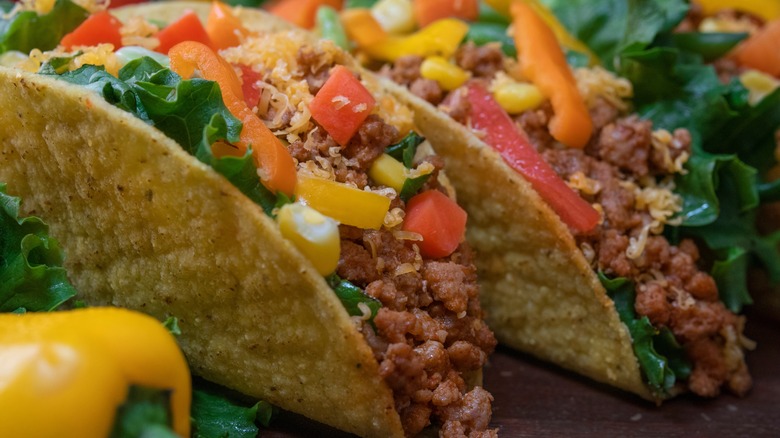11 Red Flags To Look Out For At Mexican Restaurants
Is there any food more ubiquitous in American culture than Mexican food? Italian cuisine is probably a close second. Similar to Italian food, there are dozens of ways to get bad versions of food dubbed "Mexican" in the United States.
The first deviation is Tex-Mex, a version of Mexican food created in the United States to replicate authentic cuisine. While it can be good, it relies on re-creating traditional food. Over time, it has devolved into something else entirely, leading to the invention of Mexican fast-food options. Other places that tried to create Tex-Mex or authentic food have utterly failed. The result is overly Americanized versions of Mexican cuisine that are unrecognizable compared to the originals — from their food and drinks offerings to how they serve these items.
You want to avoid these places when deciding what Mexican restaurants to visit. But how do you know which ones are worth patronizing and which aren't? We're here to tell you what to look for when determining whether the Mexican restaurant you're considering making a trip to is worth it. Keep reading to learn how to spot a "Mexican" restaurant you should avoid.
There are only flour tortillas
It's common knowledge that corn tortillas rank higher than flour tortillas in Mexican cuisine. Why? Wheat was not an ingredient available to Mexicans until the Spanish arrived in America from Europe with the product in tow. Corn is abundant in Central America, so the crop is a vital ingredient in many dishes like tortillas. On the other hand, the flour variety is only readily available in the northernmost parts of Mexico and Northern America — putting flour tortillas firmly in the Tex-Mex category.
Corn tortillas are traditionally used for tacos and were often available from street vendors. Many food trucks in the U.S. that serve street tacos use corn tortillas. The consistency of these is quite different from flour tortillas. The corn variety is thicker and a bit sturdier than the flour counterparts, and they also tend to be smaller. Flour tortillas work best for burritos because they are more compatible, flexible, and bigger medium to hold those fillings.
The entire staff only speaks English
Regardless of the type of Mexican restaurant you're in, many of the staff likely speak Spanish — especially if you're in a border state. If the staff speaks to one another entirely in English, it's a good sign that it won't be a good restaurant. Ideally, you want the workers in a Mexican restaurant to be from Mexico or at least within a few generations of living there. This is, after all, their country's food. According to Mashed, if the staff is from Mexico or raised by family members who were, the food is more likely to be authentic.
This makes sense when you consider the fact that families pass down recipes from generation to generation. Having experience outside the restaurant with similar foods definitely contributes to a more authentic experience onsite. That is why you should look for a family feel in the restaurant. In Mexico, several generations of a family often run the same establishment. Recreating that atmosphere in this country goes a long way to creating an authentic experience and food.
The guacamole and salsa aren't made fresh
What's the easiest way to tell a fake Mexican restaurant from a real one? Look to see if their sauces come from jars. Salsa, guacamole, and mole are all made fresh daily and frequently in authentic Mexican restaurants. In most Mexican restaurants in the United States (or ones outside the U.S. that cater to Americans), you'll find that freshly made salsa and guacamole are served with chips before the arrival of your meal.
The fresher the ingredients in your salsas and guacamoles, the better the restaurant: This is doubly true with guacamole. Since avocado browns after being exposed to the air, the greener your guacamole looks, the fresher it'll be. But be on the lookout for artificial green coloring. If it's neon green or within that unnatural-looking range, run, don't walk, from the restaurant!
If you've managed to find a restaurant that serves mole, it's a good sign that you are in an authentic Mexican restaurant. "Mole recipes are notoriously complex to prepare (per Cascana)." Inauthentic restaurants are unlikely to go to the trouble of producing these chili-based sauces passed down through generations of families.
The arroz con pollo features a cheese-like ingredient
Arroz con pollo means rice with chicken in Spanish. Traditionally, arroz con pollo contains saffron-colored rice served with roasted, golden chicken. But in the artificial Mexican restaurants you should avoid, it has morphed into something else entirely. It has been replaced by flavorless rice and bland chicken topped with a queso-style cheese sauce of indeterminate consistency.
Most likely found in the southern United States, the dish is often listed on the menu as "ACP." In addition to chicken, it might include sausage, shrimp, or beef in a concoction that's more creole than Mexican. Chefs in the region concede it's a dish only white, working-class customers order. Many said they never heard of the dish before working as chefs at a location that served it.
If you're looking for authentic Mexican food, you don't want one that serves ACP. Though you'll find it in Mexican restaurants in the South, this version of arroz con pollo never became popular enough to end up in Mexican restaurants outside the area. When a food can't even establish itself as a successful Tex-Mex menu item, you want to avoid it altogether.
There's no cilantro anywhere
While Tex-Mex and less authentic Mexican food rely on powdered herbs and spices, traditional restaurants rely on fresh, whole herbs. A vital herb for Mexican dishes is cilantro — the leafy part of the coriander plant. If you don't see the herb featured heavily in the dishes being served, you may want to start looking for an alternative restaurant. Cilantro is commonly used in pico de gallo, guacamole, and salsas. But it is also served as a topping for tacos, enchiladas, and soups. Both the stems and the leaves add a fresh flavor to dishes featuring meat or seafood.
An added benefit of using cilantro is that the herb's cool flavor complements the spiciness of Mexican food. The herb even has medicinal properties that make it an excellent accompaniment to Mexican food: It helps prevent heartburn! However, the herb can taste metallic or soapy to certain people due to genetics. But if that doesn't affect you, embrace its vital role in (almost every kind of) traditional Mexican dish. If none of the options on the menu at your Mexican restaurant list cilantro as an ingredient, you want to find an eatery that does.
Flavored margaritas abound
Traditional margaritas are made from a handful of ingredients: tequila, lime juice, orange liqueur, ice, salt, and limes. Seeing a variety of flavored margarita options happens more in American-style restaurants like Applebee's and Ruby Tuesday's. Margaritas may not even be authentically Mexican: They are not common in places like Mexico City unless you're someplace touristy, and sometimes not even there! When you do find them, they contain simple ingredients.
While flavored varieties of the drink might be delicious, they are far from authentic. So if you find yourself in a Mexican restaurant that serves half a dozen (or more) flavors of margaritas, you should see it as a red flag that the food in the restaurant is not traditional either. You may be able to find a wider variety of margarita flavors in a Tex-Mex restaurant, where the food may still be good, though not as authentic. But they are often made from packaged mixes and loaded with sugar.
There are double-decker items on the menu
The only place you'll find double-decker Mexican food is at Taco Bell. What's a double-decker? The simple concept is this: a soft taco wrapped around a hard taco, either with or without a nacho cheese adhesive between the two. But it hardly takes a rocket scientist to figure out that Mexican fast food served in America is far from authentic.
Another reason this doesn't work? It combines multiple Mexican dishes into one, which traditional approaches don't do. Consider the double-decker taco, which combines a flour tortilla with a crispy corn taco shell. Similarly, another option that muddies Mexican food culture comes (again) from Taco Bell — the Mexican pizza: two corn tortillas with meat and refried beans sandwiched between them, topped with sauce, cheese, and tomatoes. Anytime a restaurant tries to combine two disparate food types into one, it guarantees the item will be an American-produced item. If the Mexican restaurant you're going to features items you can find on a Taco Bell menu, you should pass.
Chips and cheese (or nachos) are on the menu
To be fair, nachos originated in Mexico — but only to serve Americans at a restaurant that had already closed for the evening (via The New York Times). The restaurant fried some leftover tortillas and topped them with cheese, jalapenos, and leftovers on hand. While the modern version — doused in meats, vegetables, and sour cream — is popular in Mexico and America, they are not traditional Mexican food. You're unlikely to find the dressed-up version in a traditional Mexican restaurant.
Another thing you won't find in authentic Mexican restaurants is what's known as "ballpark nachos." You can find these nachos at basketball games or in theaters. They come with a cheese sauce that retains its liquid form at room temperature. They may or may not come with pickled jalapenos served on tortilla chips. In less authentic Mexican restaurants, you may find chips and liquid cheese offered complimentary at the start of the meal or as an appetizer option. (Of course, you can order chips and cheese at Taco Bell.) This food is delicious — even native Mexicans love it, but it is not traditional. If that is what you're aiming for, you should find a place without nachos on the menu.
The tacos have lettuce, tomatoes, or shredded cheddar
Surprisingly, ground beef isn't a traditional filling for tacos in Mexico. Seafood, carnitas, vegetables, and barbacoa-style meats were used in the original tacos. (Fried grasshoppers are still popular in the Oaxaca region!)
In authentic tacos, there is cheese, but not the shredded variety found in the United States and in less authentic Mexican food restaurants. Authentic Mexican cheese tacos use Panella, a salty cheese that retains its shape when heated. Like the more customary meats and vegetables, it serves as the filling for the taco instead of a topping.
As for the toppings that go on the meats and cheeses in traditional tacos? The Mexican variety starts with a squirt of lime juice. It works beautifully on its own to help bring out the existing flavor of your taco fillings. It's sufficient as the only topping on your taco, but you don't have to stop there! Other common additions include cilantro, onions, radishes, cucumber, avocado, and chili peppers. Only the Tex-Mex variety of tacos has heaps of lettuce, diced tomato, and shredded cheddar.
Your only option is American soda
Traditional Mexican restaurants will offer some conventional Mexican beverages, not just Coke or Pepsi products. Mexican Coke is the most common of these and the one you're likeliest to have seen. The only real difference between Mexican Coke and the American variety is that the former uses cane sugar — rather than artificial sweeteners — and comes in a glass bottle. Believe it or not, the bottle does make a difference. Drinks in plastic and aluminum do not taste the same as those in a glass bottle. Mexican Coke is far from being the only Mexican soda option.
Other standard options include Jarritos, which you may have seen in your local grocery store. The brand has 11 flavors, including pineapple, strawberry, watermelon, and mango. It's probably the most popular Mexican soda. There's also a lesser-known apple soda by Mundet that's flavored with different types of apples. Topo Sabores makes a very sweet soda in pineapple and strawberry flavors. In a traditional Mexican restaurant, sangria is typically available for adults too.
Another option you're likely to encounter in an authentic Mexican restaurant is a horchata. This beverage resembles milk, but it's a non-dairy concoction made by soaking grains in water overnight. Modern-day versions are typically made with rice and sugar and accented by spices like cinnamon.
All the taco shells are crispy
Though you may have the option of hard or soft-shell tacos in American restaurants, the latter showcases traditional Mexican cuisine. Tacos were originally served in soft shells. In many parts of Mexico, soft-shell tacos come from a street vendor. Soft corn shells make them easy to eat while going to work or coming home. Authentic Mexican restaurants still favor the soft-shell option.
Although you can order a hard taco at almost every Mexican restaurant you dine at in America, finding hard shell tacos in restaurants in Mexico isn't easy. They are available there, but generally as a fast-food option. The same can be said for this type of taco shell when you find it in the United States — it is a fast-food option.
Hard shell tacos debuted in 1948, and Glenn Bell, who opened the first Taco Bell in 1962, popularized the item Kitchen Bun. While the trend certainly took hold in the United States, serving tacos in hard shells did not have as much success in Mexico. Hard shell tacos may be an economical and efficient option, but they are not authentic.
